Naïve Primary Mouse CD8+ T Cells Retain In Vivo Immune Responsiveness After Electroporation-Based CRISPR/Cas9 Genetic Engineering
- PMID: 35844563
- PMCID: PMC9280190
- DOI: 10.3389/fimmu.2022.777113
Naïve Primary Mouse CD8+ T Cells Retain In Vivo Immune Responsiveness After Electroporation-Based CRISPR/Cas9 Genetic Engineering
Abstract
CRISPR/Cas9 technology has revolutionized genetic engineering of primary cells. Although its use is gaining momentum in studies on CD8+ T cell biology, it remains elusive to what extent CRISPR/Cas9 affects in vivo function of CD8+ T cells. Here, we optimized nucleofection-based CRISPR/Cas9 genetic engineering of naïve and in vitro-activated primary mouse CD8+ T cells and tested their in vivo immune responses. Nucleofection of naïve CD8+ T cells preserved their in vivo antiviral immune responsiveness to an extent that is indistinguishable from non-nucleofected cells, whereas nucleofection of in vitro-activated CD8+ T cells led to slightly impaired expansion/survival at early time point after adoptive transfer and more pronounced contraction. Of note, different target proteins displayed distinct decay rates after gene editing. This is in stark contrast to a comparable period of time required to complete gene inactivation. Thus, for optimal experimental design, it is crucial to determine the kinetics of the loss of target gene product to adapt incubation period after gene editing. In sum, nucleofection-based CRISPR/Cas9 genome editing achieves efficient and rapid generation of mutant CD8+ T cells without imposing detrimental constraints on their in vivo functions.
Keywords: CD8+ T cell genetic engineering; CRISPR/Cas9; antiviral immunity; gene inactivation; nucleofection; primary CD8+ T cell; target protein depletion.
Copyright © 2022 Pfenninger, Yerly and Abe.
Conflict of interest statement
The authors declare that the research was conducted in the absence of any commercial or financial relationships that could be construed as a potential conflict of interest.
Figures

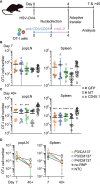
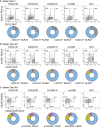
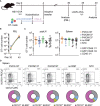
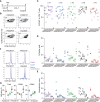
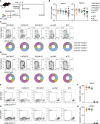

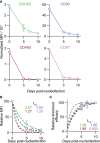
Similar articles
-
Efficient CRISPR/Cas9 Gene Editing in Uncultured Naive Mouse T Cells for In Vivo Studies.J Immunol. 2020 Apr 15;204(8):2308-2315. doi: 10.4049/jimmunol.1901396. Epub 2020 Mar 9. J Immunol. 2020. PMID: 32152070
-
Rapid and Efficient Gene Editing for Direct Transplantation of Naive Murine Cas9+ T Cells.Front Immunol. 2021 Jul 21;12:683631. doi: 10.3389/fimmu.2021.683631. eCollection 2021. Front Immunol. 2021. PMID: 34367143 Free PMC article.
-
Rapid and efficient generation of antigen-specific isogenic T cells from cryopreserved blood samples.Immunol Cell Biol. 2022 Apr;100(4):285-295. doi: 10.1111/imcb.12538. Epub 2022 Mar 21. Immunol Cell Biol. 2022. PMID: 35194830 Free PMC article.
-
Delivery strategies of the CRISPR-Cas9 gene-editing system for therapeutic applications.J Control Release. 2017 Nov 28;266:17-26. doi: 10.1016/j.jconrel.2017.09.012. Epub 2017 Sep 11. J Control Release. 2017. PMID: 28911805 Free PMC article. Review.
-
Engineering T Cells Using CRISPR/Cas9 for Cancer Therapy.Methods Mol Biol. 2020;2115:419-433. doi: 10.1007/978-1-0716-0290-4_23. Methods Mol Biol. 2020. PMID: 32006414 Review.
Cited by
-
Synergizing CRISPR-Cas9 with Advanced Artificial Intelligence and Machine Learning for Precision Drug Delivery: Technological Nexus and Regulatory Insights.Curr Gene Ther. 2025;25(4):467-496. doi: 10.2174/0115665232342293241120033251. Curr Gene Ther. 2025. PMID: 39871553 Review.
-
CRISPR-Cas9 applications in T cells and adoptive T cell therapies.Cell Mol Biol Lett. 2024 Apr 12;29(1):52. doi: 10.1186/s11658-024-00561-1. Cell Mol Biol Lett. 2024. PMID: 38609863 Free PMC article. Review.
-
CRISPR/Cas9 systems: Delivery technologies and biomedical applications.Asian J Pharm Sci. 2023 Nov;18(6):100854. doi: 10.1016/j.ajps.2023.100854. Epub 2023 Oct 21. Asian J Pharm Sci. 2023. PMID: 38089835 Free PMC article. Review.
References
Publication types
MeSH terms
LinkOut - more resources
Full Text Sources
Molecular Biology Databases
Research Materials

